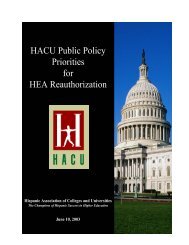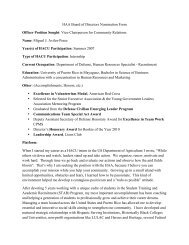The Latino Labor Force at a Glance - United States Department of ...
The Latino Labor Force at a Glance - United States Department of ...
The Latino Labor Force at a Glance - United States Department of ...
Create successful ePaper yourself
Turn your PDF publications into a flip-book with our unique Google optimized e-Paper software.
<strong>The</strong> <strong>L<strong>at</strong>ino</strong><br />
<strong>Labor</strong> <strong>Force</strong><br />
<strong>at</strong> a <strong>Glance</strong><br />
April 5, 2012<br />
U.S. <strong>Department</strong> <strong>of</strong> <strong>Labor</strong>
THE LATINO LABOR FORCE AT A GLANCE<br />
At nearly 23 million, people <strong>of</strong> Hispanic or <strong>L<strong>at</strong>ino</strong> ethnicity represented 15 percent <strong>of</strong> the U.S. labor force in 2011. 1<br />
By 2018, Hispanics are expected to comprise 18 percent <strong>of</strong> the labor force.<br />
In 2011, 58.9 percent <strong>of</strong> <strong>L<strong>at</strong>ino</strong>s aged 16 and over were employed and just under 1 in 5 <strong>of</strong> those employed was working<br />
part-time. Women comprised 41 percent <strong>of</strong> all <strong>L<strong>at</strong>ino</strong>s in the labor force in 2011, compared to 46 percent among<br />
the white labor force. 2 Women represent a smaller share <strong>of</strong> the <strong>L<strong>at</strong>ino</strong> labor force both because <strong>of</strong> the high labor<br />
force particip<strong>at</strong>ion <strong>of</strong> <strong>L<strong>at</strong>ino</strong> men and the lower labor force particip<strong>at</strong>ion r<strong>at</strong>e <strong>of</strong> L<strong>at</strong>ina women when compared to<br />
Whites. 3<br />
Employed <strong>L<strong>at</strong>ino</strong>s are much less<br />
likely to have a college degree<br />
than are either Whites or African<br />
Americans. 4 Approxim<strong>at</strong>ely one<br />
in six employed <strong>L<strong>at</strong>ino</strong>s aged<br />
25 and over have completed a<br />
bachelor’s degree, less than half<br />
the proportion among employed<br />
Whites. Since 2000, this gap in<br />
the share <strong>of</strong> employed <strong>L<strong>at</strong>ino</strong>s and<br />
Whites who are college gradu<strong>at</strong>es<br />
has widened. Between 2000 and<br />
2011, the gap between employed<br />
Whites with a college educ<strong>at</strong>ion<br />
and employed <strong>L<strong>at</strong>ino</strong>s with a<br />
college educ<strong>at</strong>ion grew from 17.6<br />
percentage points to 20.1 percentage<br />
points.<br />
<strong>L<strong>at</strong>ino</strong>s are more likely than either<br />
Whites or African Americans to<br />
be employed in the priv<strong>at</strong>e sector,<br />
with more than 8 in 10 employed<br />
<strong>L<strong>at</strong>ino</strong>s working in the priv<strong>at</strong>e<br />
sector, not including the unincorpor<strong>at</strong>ed<br />
self-employed. Conversely,<br />
<strong>L<strong>at</strong>ino</strong>s are less likely to work<br />
for government than are either<br />
Whites or African Americans.<br />
Table 1. Unemployment, employment, and earnings characteristics by race<br />
and <strong>L<strong>at</strong>ino</strong> ethnicity, 2011 annual averages<br />
<strong>L<strong>at</strong>ino</strong>s Whites<br />
African<br />
Americans<br />
Characteristics <strong>of</strong> the employed<br />
% Employed (employment-popul<strong>at</strong>ion r<strong>at</strong>io 58.9 59.4 51.7<br />
among those 16 and older)<br />
% Usually working part-time 18.9 19.9 18.0<br />
% Women (age 16 and over) 40.6 46.0 53.8<br />
% College gradu<strong>at</strong>es (age 25 and over) 16.7 36.1 26.0<br />
% Working in the priv<strong>at</strong>e sector (wage and 83.7 78.5 76.9<br />
salary workers)<br />
% Working in the public sector 10.4 14.2 19.3<br />
% Self-employed (unincorpor<strong>at</strong>ed) 5.8 7.2 3.8<br />
Weekly earnings<br />
Total $549 $775 $615<br />
Men $571 $856 $653<br />
Women $518 $703 $595<br />
Characteristics <strong>of</strong> the unemployed<br />
Unemployment r<strong>at</strong>e 11.5 7.9 15.8<br />
% Women (age 16 and over) 41.9 43.0 46.9<br />
Median dur<strong>at</strong>ion <strong>of</strong> unemployment in weeks 18.5 19.7 27.0<br />
% Long-term unemployed (27 weeks or more) 39.9 41.7 49.5<br />
Source: Bureau <strong>of</strong> <strong>Labor</strong> St<strong>at</strong>istics, Current Popul<strong>at</strong>ion Survey<br />
Note: Persons whose ethnicity is identified as Hispanic or <strong>L<strong>at</strong>ino</strong> may be <strong>of</strong> any race. Those<br />
identified as White or Black includes those <strong>L<strong>at</strong>ino</strong>s who selected White or Black when<br />
queried about their race.<br />
1 <strong>The</strong> U.S. Office <strong>of</strong> Management and Budget currently defines “Hispanic or <strong>L<strong>at</strong>ino</strong>” as “a person <strong>of</strong> Mexican, Puerto Rican, Cuban, South or Central American,<br />
or other Spanish culture or origin, regardless <strong>of</strong> race.<br />
2 <strong>L<strong>at</strong>ino</strong>s who select white when identifying race are included in the White c<strong>at</strong>egory as well as the <strong>L<strong>at</strong>ino</strong> c<strong>at</strong>egory.<br />
3 A possible reason why L<strong>at</strong>ina women may have lower particip<strong>at</strong>ion r<strong>at</strong>es is th<strong>at</strong> immigrant L<strong>at</strong>ina women come from countries with lower labor force<br />
particip<strong>at</strong>ion and tend to have similarly lower labor force particip<strong>at</strong>ion. In 2011, nearly half (46.4 percent) <strong>of</strong> the female L<strong>at</strong>ina labor force was foreign-born<br />
while across the entire female labor force, 14 percent were foreign-born. See, F. Blau, L. Kahn and K. Papps. 2011. “Gender, Source Country Characteristics<br />
and <strong>Labor</strong> Market Assimil<strong>at</strong>ion Among Immigrants: 1980-2000,” Review <strong>of</strong> Economics and St<strong>at</strong>istics, 93(1): 43-58.<br />
4 <strong>L<strong>at</strong>ino</strong>s who select black when identifying race are included in the Black c<strong>at</strong>egory as well as the <strong>L<strong>at</strong>ino</strong> c<strong>at</strong>egory.<br />
THE LATINO LABOR FORCE AT A GLANCE • PAGE 1
In 2011, 5.8 percent <strong>of</strong> <strong>L<strong>at</strong>ino</strong>s were self-employed compared to 7.2 percent among Whites. <strong>The</strong> lower self-employment<br />
among <strong>L<strong>at</strong>ino</strong>s is partly <strong>at</strong>tributed to lower educ<strong>at</strong>ional <strong>at</strong>tainment and to less access to financial wealth. 5<br />
However, according to the most recent Census Bureau Survey <strong>of</strong> Business Owners (2007), <strong>L<strong>at</strong>ino</strong>-owned businesses<br />
were the fastest growing small business sector prior to the recession, expanding <strong>at</strong> nearly twice the r<strong>at</strong>e <strong>of</strong> the n<strong>at</strong>ional<br />
average between 2002 and 2007. In fact, the entry r<strong>at</strong>e <strong>of</strong> <strong>L<strong>at</strong>ino</strong>s into self-employment compares favorably to<br />
th<strong>at</strong> <strong>of</strong> non-<strong>L<strong>at</strong>ino</strong> Whites and their entry r<strong>at</strong>e is even higher than th<strong>at</strong> <strong>of</strong> Whites in low-barrier sectors. <strong>The</strong> main<br />
problem is th<strong>at</strong> <strong>L<strong>at</strong>ino</strong>s tend to have lower success r<strong>at</strong>es with their new businesses and exit self-employment <strong>at</strong> a<br />
higher r<strong>at</strong>e than Whites. 6<br />
Half <strong>of</strong> <strong>L<strong>at</strong>ino</strong>s working full-time earned <strong>at</strong> least $549 per week in 2011. This median weekly wage was only 71<br />
percent <strong>of</strong> th<strong>at</strong> earned by Whites. This gap in earning has been largely stable over the recession and recovery period.<br />
Some <strong>of</strong> the wage differences between <strong>L<strong>at</strong>ino</strong>s and non-<strong>L<strong>at</strong>ino</strong>s can be explained by the usual differences in educ<strong>at</strong>ion<br />
and other standard worker characteristics, such as experience and certain demographic characteristics. However,<br />
part <strong>of</strong> the wage gap between <strong>L<strong>at</strong>ino</strong>s and non-<strong>L<strong>at</strong>ino</strong>s is due to factors specific to immigrant popul<strong>at</strong>ions such<br />
as language pr<strong>of</strong>iciency or time since arrival. 7<br />
<strong>The</strong> unemployment r<strong>at</strong>e averaged 11.5 percent among <strong>L<strong>at</strong>ino</strong>s in 2011. <strong>The</strong> most recent unemployment report in<br />
February 2012 shows improvement for all Americans, including <strong>L<strong>at</strong>ino</strong>s, who have seen their unemployment r<strong>at</strong>e<br />
decline to 10.7 percent in February from a high <strong>of</strong> 13.1 percent in November 2010. In addition, unemployed <strong>L<strong>at</strong>ino</strong>s<br />
experience a shorter dur<strong>at</strong>ion <strong>of</strong> unemployment and are less likely to join the ranks <strong>of</strong> the long-term unemployed<br />
than are either their unemployed white or black counterparts.<br />
PERIODS OF HIGH UNEMPLOYMENT<br />
<strong>The</strong> n<strong>at</strong>ional unemployment r<strong>at</strong>e peaked <strong>at</strong> 10.0 percent in October 2009 but stood <strong>at</strong> 7.8 percent in January 2009<br />
after climbing from 5.0 percent in January 2008. Among <strong>L<strong>at</strong>ino</strong>s, the unemployment r<strong>at</strong>e reached a high <strong>of</strong> 13.1<br />
percent the following year in November 2010; it peaked for Whites <strong>at</strong> 9.3 percent in October 2009 and <strong>at</strong> 16.7<br />
percent among African Americans in March 2010 and again in August 2011 (see Chart 1). <strong>The</strong>se racial differences,<br />
with <strong>L<strong>at</strong>ino</strong>s having higher unemployment r<strong>at</strong>es than Whites but lower than African Americans, are long-standing.<br />
For example, <strong>at</strong> the start <strong>of</strong> the recession in December 2007, the unemployment r<strong>at</strong>e for <strong>L<strong>at</strong>ino</strong>s was 6.3 percent,<br />
compared to 4.4 percent for Whites and 9.0 percent for African Americans. In addition, the unemployment r<strong>at</strong>e for<br />
<strong>L<strong>at</strong>ino</strong>s is more vol<strong>at</strong>ile, which may be partly due to the fact th<strong>at</strong> the unemployment r<strong>at</strong>e <strong>of</strong> foreign-born <strong>L<strong>at</strong>ino</strong>s<br />
is more cyclical than th<strong>at</strong> <strong>of</strong> the n<strong>at</strong>ive born. 8 Moreover, the fact th<strong>at</strong> <strong>L<strong>at</strong>ino</strong>s are over-represented in some <strong>of</strong> the<br />
industries th<strong>at</strong> lost the most jobs, including construction and manufacturing, but underrepresented in the only two<br />
industries which continued to cre<strong>at</strong>e jobs during the recession (government as well as educ<strong>at</strong>ion and health services)<br />
contributed to <strong>L<strong>at</strong>ino</strong>s suffering a harder hit from the recession.<br />
While the unemployment r<strong>at</strong>e peaked for <strong>L<strong>at</strong>ino</strong>s a year after it peaked among Whites, the unemployment r<strong>at</strong>e<br />
remained elev<strong>at</strong>ed for all groups from the fall <strong>of</strong> 2009 through much <strong>of</strong> 2011. As illustr<strong>at</strong>ed in Chart 1, <strong>L<strong>at</strong>ino</strong>s faced<br />
5 For inform<strong>at</strong>ion on financial assets by demographic group, See: “Changes in U.S. Family Finances from 2004 to 2007: Evidence from the Survey <strong>of</strong> Consumer<br />
Finances” Brian K. Bucks, Arthur B. Kennickell, Traci L. Mach and Kevin B. Moore Federal Reserve Bulletin, vol. 95 (February 2009), pp. A1-A55 Table 6. http://<br />
www.federalreserve.gov/econresd<strong>at</strong>a/scf/files/2007_scf09.pdf and US Census Bureau Survey <strong>of</strong> Income and Program Particip<strong>at</strong>ion 2004 panel http://www.<br />
census.gov/hhes/www/wealth/2004/wlth04-1.html<br />
6 See M. L<strong>of</strong>strom and C. Wang. 2006. “Hispanic Self-Employment: A Dynamic Analysis <strong>of</strong> Business Ownership,” IZA Working Paper No. 2101. To define a<br />
sector as “low-barrier”, the authors use measures <strong>of</strong> human and financial capital requirements to enter the industry.<br />
7 Evidence on language pr<strong>of</strong>iciency shows th<strong>at</strong> this is an important determinant <strong>of</strong> wage gaps (see W. McManus, W. Gould and F. Welch. 1983. “Earnings <strong>of</strong><br />
Hispanic Men: <strong>The</strong> role <strong>of</strong> English Language Pr<strong>of</strong>iciency,” Journal <strong>of</strong> <strong>Labor</strong> Economics, 1(2): 101-130; G. Grenier. 1984. “<strong>The</strong> Effects <strong>of</strong> Language Characteristics<br />
on the Wages <strong>of</strong> Hispanic-American Males. Journal <strong>of</strong> Human Resources, 19(1): 35-5). For evidence on assimil<strong>at</strong>ion <strong>of</strong> immigrant earnings see G. Borjas.<br />
2003. “Assimil<strong>at</strong>ion and Changes in the Cohort Quality Revisited: Wh<strong>at</strong> Happened to Immigrant Earnings in the 1980s” and J. Smith. 2003.”Assimil<strong>at</strong>ion<br />
Across the <strong>L<strong>at</strong>ino</strong> Gener<strong>at</strong>ions, American Economic Review, 93(2): 315-319.<br />
8 For evidence on the gre<strong>at</strong>er cyclicality <strong>of</strong> labor market activity <strong>of</strong> immigrants see B. Chiswick, Y. Cohen and T. Zach. 1997. “<strong>The</strong> <strong>Labor</strong> Market st<strong>at</strong>us <strong>of</strong> Immigrants:<br />
Effects <strong>of</strong> the Unemployment R<strong>at</strong>e <strong>at</strong> Arrival and Dur<strong>at</strong>ion <strong>of</strong> Residence,” Industrial and <strong>Labor</strong> Rel<strong>at</strong>ions Reivew, 50(2): 289-303.<br />
THE LATINO LABOR FORCE AT A GLANCE • PAGE 2
an unemployment r<strong>at</strong>e <strong>of</strong> 13.0<br />
percent in October 2009 when the<br />
r<strong>at</strong>e peaked among Whites. <strong>The</strong><br />
gap in the unemployment r<strong>at</strong>es<br />
<strong>of</strong> <strong>L<strong>at</strong>ino</strong>s and Whites was largely<br />
steady between October 2009 and<br />
November 2010 <strong>at</strong> approxim<strong>at</strong>ely<br />
3.7 percentage points.<br />
Since reaching its high point in<br />
November 2010, the overall <strong>L<strong>at</strong>ino</strong><br />
unemployment r<strong>at</strong>e has fallen<br />
by 2.4 percentage points as <strong>of</strong><br />
February 2012. As illustr<strong>at</strong>ed in<br />
Table 2, the reduction in <strong>L<strong>at</strong>ino</strong><br />
unemployment r<strong>at</strong>es has been<br />
broad-based with <strong>L<strong>at</strong>ino</strong>s <strong>of</strong> all age<br />
groups seeing their unemployment<br />
r<strong>at</strong>es decline from 2010 to 2011.<br />
(percent)<br />
18<br />
16<br />
14<br />
12<br />
10<br />
8<br />
6<br />
4<br />
2<br />
0<br />
Chart 1: Unemployment R<strong>at</strong>e for African Americans, <strong>L<strong>at</strong>ino</strong>s and Whites<br />
Chart 1: Unemployment R<strong>at</strong>e for African Americans, <strong>L<strong>at</strong>ino</strong>s and Whites <br />
(seasonally<br />
(Seasonally Adjusted<br />
adjusted<br />
Monthly<br />
monthly,<br />
D<strong>at</strong>a,<br />
January<br />
January<br />
2007<br />
2007-<br />
- February<br />
February<br />
2012)<br />
2012)<br />
African American<br />
Peak Unemployment : 16.7%<br />
March 2010 and August 2011<br />
White <br />
Peak Unemployment: 9.3%<br />
October 2009<br />
2007 - Jan 2007 - Jul 2008 - Jan 2008 - Jul 2009 - Jan 2009 - Jul 2010 - Jan 2010 - Jul 2011 - Jan 2011 - Jul 2012 - Jan<br />
Source: Bureau <strong>of</strong> <strong>Labor</strong> <strong>of</strong> <strong>Labor</strong> St<strong>at</strong>istics, St<strong>at</strong>istics, Current Current Popul<strong>at</strong>ion Popul<strong>at</strong>ion Survey Survey<br />
<strong>L<strong>at</strong>ino</strong><br />
Peak Unemployment: 13.1%<br />
November 2010<br />
Table 2: <strong>L<strong>at</strong>ino</strong> Unemployment R<strong>at</strong>es by Age Group<br />
Year 16-19 20-24 25-34 35-44 45-54<br />
2007 18.1 7.8 4.9 4.3 4.3<br />
2008 22.4 11.5 6.7 5.8 6.3<br />
2009 30.2 16.2 11.4 10.2 10.1<br />
2010 32.2 17.4 11.3 10.3 10.8<br />
2011 31.1 15.7 10.4 9.2 9.9<br />
Change from 2010 to 2011 -1.1 -1.7 -0.9 -1.1 -0.9<br />
Source: Bureau <strong>of</strong> <strong>Labor</strong> St<strong>at</strong>istics, Current Popul<strong>at</strong>ion Survey<br />
Chart 2 shows annual unemployment<br />
averages for <strong>L<strong>at</strong>ino</strong> men,<br />
women, and youth (ages 16-19). 9<br />
Reversing the p<strong>at</strong>tern <strong>of</strong> the prior<br />
two years, the unemployment<br />
r<strong>at</strong>e in 2011 among <strong>L<strong>at</strong>ino</strong> men<br />
was lower than th<strong>at</strong> among<br />
L<strong>at</strong>ina women. This narrowing<br />
occurred as unemployment among<br />
adult <strong>L<strong>at</strong>ino</strong> men declined 1.4<br />
percentage points, while it was<br />
little changed among adult L<strong>at</strong>ina<br />
women. <strong>The</strong>re are several factors<br />
th<strong>at</strong> could have contributed to the<br />
smaller decline in unemployment<br />
among L<strong>at</strong>ina women. One<br />
potential factor is their<br />
Chart 2: Unemployment R<strong>at</strong>e among <strong>L<strong>at</strong>ino</strong>s Adult Men, Adult Women, and Youth<br />
(Annual d<strong>at</strong>a 2007 - 2012)<br />
Source: Bureau <strong>of</strong> <strong>Labor</strong> St<strong>at</strong>istics, Current Popul<strong>at</strong>ion Survey<br />
9 Monthly seasonally adjusted d<strong>at</strong>a are not available for <strong>L<strong>at</strong>ino</strong> men, women, and youth. As such, annual averages provide a more accur<strong>at</strong>e picture <strong>of</strong><br />
changes in unemployment for these groups over time.<br />
THE LATINO LABOR FORCE AT A GLANCE • PAGE 3
disproportion<strong>at</strong>e particip<strong>at</strong>ion in industries th<strong>at</strong> have continued to experience job losses, such as st<strong>at</strong>e and local<br />
government. For example, 55 percent <strong>of</strong> <strong>L<strong>at</strong>ino</strong> government workers were women in 2011.<br />
As Chart 2 also illustr<strong>at</strong>es, <strong>L<strong>at</strong>ino</strong> youth (ages 16-19) have much higher unemployment r<strong>at</strong>es than do <strong>L<strong>at</strong>ino</strong> adults.<br />
<strong>The</strong> unemployment r<strong>at</strong>e for <strong>L<strong>at</strong>ino</strong> youth declined to 31.1 percent from its high <strong>of</strong> 32.2 percent in 2010. <strong>The</strong> signs <strong>of</strong><br />
improvement have continued into 2012; as <strong>of</strong> February, the unemployment r<strong>at</strong>e had fallen to 27.5 percent from 30.6<br />
percent a year earlier. 10 Although the unemployment r<strong>at</strong>e has fallen, a large number <strong>of</strong> <strong>L<strong>at</strong>ino</strong> teens are no longer<br />
in the labor force—either working or looking for work. In 2007, <strong>L<strong>at</strong>ino</strong> teens particip<strong>at</strong>ed in the labor force <strong>at</strong> a r<strong>at</strong>e<br />
<strong>of</strong> 37.1 percent. By 2011, th<strong>at</strong> r<strong>at</strong>e had declined substantially to 28.3 percent. Some <strong>of</strong> this decline in labor force<br />
particip<strong>at</strong>ion among teens reflects an increase in the percent <strong>of</strong> teens in school. Among 16-19 year old <strong>L<strong>at</strong>ino</strong>s, 80.4<br />
percent were students in October 2011 compared to 74.9 percent in 2007, the year the recession started. 11<br />
Falling labor force particip<strong>at</strong>ion is occurring among all <strong>L<strong>at</strong>ino</strong>s; however the declines are gre<strong>at</strong>est for those who are<br />
young. Among those ages 20 to 24, labor force particip<strong>at</strong>ion ticked up to 72.0 percent in 2011 from 71.1 percent<br />
in 2010; however, the r<strong>at</strong>e remains below its 2007 average <strong>of</strong> 74.8 percent. While this decline is smaller than th<strong>at</strong><br />
experienced by teenagers, there was an even larger increase in the proportion <strong>of</strong> 20 to 24 year-olds remaining in<br />
school - 31.9 percent <strong>of</strong> 20 to 24 year old<br />
<strong>L<strong>at</strong>ino</strong>s were students in October 2011<br />
compared to 24.2 percent in October<br />
2007. After rising in 2010, the labor force<br />
particip<strong>at</strong>ion declined from 80.4<br />
percent to 79.5 percent for those ages<br />
25 to 54 in 2011, and the r<strong>at</strong>e actually<br />
rose for those over age 55. Among<br />
all <strong>L<strong>at</strong>ino</strong>s, 66.5 percent were in the<br />
labor force in 2011, compared to 68.8<br />
percent in 2007.<br />
One factor th<strong>at</strong> may explain why<br />
<strong>L<strong>at</strong>ino</strong> labor force outcomes<br />
lag behind those <strong>of</strong> their white<br />
counterparts is educ<strong>at</strong>ional<br />
<strong>at</strong>tainment. As is true for all racial<br />
and ethnic groups, the link between<br />
gre<strong>at</strong>er educ<strong>at</strong>ional <strong>at</strong>tainment and<br />
improved employment outcomes<br />
remains strong.<br />
(percent)<br />
14.0<br />
12.0<br />
10.0<br />
8.0<br />
6.0<br />
4.0<br />
2.0<br />
0.0<br />
Chart 3: Unemployment R<strong>at</strong>e for <strong>L<strong>at</strong>ino</strong>s and Whites by Educ<strong>at</strong>ional Attainment,<br />
Chart 3: Unemployment 2011 R<strong>at</strong>e Annual for <strong>L<strong>at</strong>ino</strong>s Average and Whites Age 25 and Older, by<br />
Educ<strong>at</strong>ional (Persons Attainment, 25 years and 2011 older) Annual Average<br />
12.0<br />
Unemployment r<strong>at</strong>es are lowest among those with a bachelor’s degree or higher. For instance, the 2011<br />
unemployment r<strong>at</strong>e among <strong>L<strong>at</strong>ino</strong>s with <strong>at</strong> least a bachelor’s degree was 5.7 percent, (compared to 3.9 percent for<br />
Whites). Unemployment r<strong>at</strong>es are higher for those with fewer years <strong>of</strong> schooling. In 2011, the unemployment r<strong>at</strong>e <strong>of</strong><br />
<strong>L<strong>at</strong>ino</strong>s with only a high school degree was 10.3 percent (compared to 8.4 percent <strong>of</strong> Whites with only a high school<br />
degree) and 12.0 percent for <strong>L<strong>at</strong>ino</strong>s with less than a high school degree (compared to 12.7 percent for Whites with<br />
less than a high school degree).<br />
While those with more educ<strong>at</strong>ion are less likely to experience unemployment, <strong>L<strong>at</strong>ino</strong>s <strong>of</strong> all educ<strong>at</strong>ion levels were hit<br />
hard by the recession. From 2007 to 2011, the unemployment r<strong>at</strong>e <strong>at</strong> least doubled for <strong>L<strong>at</strong>ino</strong>s <strong>at</strong> every educ<strong>at</strong>ional<br />
<strong>at</strong>tainment level. As Table 3 shows, this p<strong>at</strong>tern began to turn around in the past year. <strong>The</strong> decline in the <strong>L<strong>at</strong>ino</strong><br />
12.7<br />
Less than a High School<br />
diploma<br />
10.3<br />
8.4<br />
High School gradu<strong>at</strong>es<br />
Source: Bureau <strong>of</strong> <strong>Labor</strong> St<strong>at</strong>istics, Current Popul<strong>at</strong>ion Survey<br />
9.1<br />
7.0<br />
Some college or<br />
Associ<strong>at</strong>e's degree<br />
<strong>L<strong>at</strong>ino</strong><br />
Unemployment<br />
R<strong>at</strong>e<br />
White<br />
Unemployment<br />
R<strong>at</strong>e<br />
5.7<br />
3.9<br />
Bachelor's degree or<br />
more<br />
10 <strong>The</strong>se are not seasonally adjusted r<strong>at</strong>es as seasonally adjusted unemployment r<strong>at</strong>es by age are not available for <strong>L<strong>at</strong>ino</strong>s. However comparing February<br />
2012 to February 2011 also indic<strong>at</strong>es an improvement in the unemployment r<strong>at</strong>e among <strong>L<strong>at</strong>ino</strong> youth.<br />
11 October d<strong>at</strong>a are used as the reference month for school enrollment r<strong>at</strong>her than an annual average since most schools are in session during October<br />
School enrollment is very seasonal. Annual averages are skewed by low school <strong>at</strong>tendance r<strong>at</strong>es during the summer months.<br />
THE LATINO LABOR FORCE AT A GLANCE • PAGE 4
unemployment r<strong>at</strong>e has occurred <strong>at</strong> every educ<strong>at</strong>ional level, with both highly educ<strong>at</strong>ed and less educ<strong>at</strong>ed <strong>L<strong>at</strong>ino</strong>s<br />
seeing their unemployment r<strong>at</strong>es decline in 2011.<br />
Table 3: <strong>L<strong>at</strong>ino</strong> Unemployment R<strong>at</strong>es by Educ<strong>at</strong>ional Attainment, Annual Averages Not Seasonally Adjusted<br />
Year Less than HS High School Some college College<br />
2007 6.0 4.4 4.1 2.3<br />
2008 8.2 6.2 5 3.4<br />
2009 13.7 10.4 9.2 5.7<br />
2010 13.2 11.5 9.7 6<br />
2011 12.0 10.3 9.1 5.7<br />
Change from 2010 to 2011 -1.2 -1.2 -0.6 -0.3<br />
Source: Bureau <strong>of</strong> <strong>Labor</strong> St<strong>at</strong>istics, Current Popul<strong>at</strong>ion Survey<br />
<strong>The</strong> <strong>L<strong>at</strong>ino</strong> labor force is significantly more likely to be foreign born than the general popul<strong>at</strong>ion. In 2011, 52.2<br />
percent <strong>of</strong> the <strong>L<strong>at</strong>ino</strong> labor force was foreign born compared to only 15.9 percent <strong>of</strong> the overall labor force. Foreignborn<br />
<strong>L<strong>at</strong>ino</strong>s have traditionally had lower unemployment r<strong>at</strong>es than have n<strong>at</strong>ive-born <strong>L<strong>at</strong>ino</strong>s. <strong>The</strong> unemployment<br />
r<strong>at</strong>es more than doubled among both groups between 2006 and 2010. In 2011, unemployment r<strong>at</strong>es declined for<br />
both groups.<br />
Table 4: <strong>L<strong>at</strong>ino</strong> Unemployment R<strong>at</strong>es by N<strong>at</strong>ive St<strong>at</strong>us, Not Seasonally Adjusted, Annual Averages, Age 16 and over<br />
Year All <strong>L<strong>at</strong>ino</strong>s N<strong>at</strong>ive-born <strong>L<strong>at</strong>ino</strong>s Foreign-born <strong>L<strong>at</strong>ino</strong>s<br />
2005 6.0 7.2 5.0<br />
2006 5.2 6.2 4.5<br />
2007 5.6 6.6 4.9<br />
2008 7.6 8.4 6.9<br />
2009 12.1 12.9 11.4<br />
2010 12.5 13.8 11.3<br />
2011 11.5 13.0 10.1<br />
Change from 2010 to 2011 -1.0 -0.8 -1.2<br />
Source: Bureau <strong>of</strong> <strong>Labor</strong> St<strong>at</strong>istics, Current Popul<strong>at</strong>ion Survey<br />
Within the <strong>L<strong>at</strong>ino</strong> labor force, unemployment r<strong>at</strong>es vary by ethnic subpopul<strong>at</strong>ion. Puerto Ricans have historically<br />
had the highest unemployment r<strong>at</strong>es, while Cuban-Americans traditionally have had the lowest. Among the three<br />
major <strong>L<strong>at</strong>ino</strong> subgroups (Mexican-American, Puerto Rican, and Cuban-American), unemployment r<strong>at</strong>es rose<br />
sharply from 2006 to 2010. All three groups saw improvements in 2011; however, the Puerto Rican unemployment<br />
r<strong>at</strong>e was 2.6 percentage points above the overall <strong>L<strong>at</strong>ino</strong> unemployment r<strong>at</strong>e <strong>of</strong> 11.5 percent in 2011.<br />
Unemployment varies across the <strong>United</strong> St<strong>at</strong>es and the unemployment r<strong>at</strong>e <strong>of</strong> <strong>L<strong>at</strong>ino</strong>s, like th<strong>at</strong> <strong>of</strong> other Americans,<br />
differs depending on the st<strong>at</strong>e in which they live. <strong>L<strong>at</strong>ino</strong>s facing the highest unemployment r<strong>at</strong>es in 2011 reside<br />
in Rhode Island (21.6 percent), Connecticut (17.8 percent), Washington (14.8 percent), Nevada (14.5 percent),<br />
and Pennsylvania (14.5 percent), while those facing the lowest r<strong>at</strong>es live in Alaska (4.3 percent), West Virginia (5.6<br />
percent), Virginia (5.8 percent), Maryland (7.0 percent), Arkansas (7.3 percent), and the District <strong>of</strong> Columbia (7.3<br />
percent).<br />
<strong>The</strong> supplemental map <strong>at</strong> the end <strong>of</strong> this report highlights the st<strong>at</strong>es where the largest numbers <strong>of</strong> unemployed<br />
<strong>L<strong>at</strong>ino</strong> workers reside. As one would expect, st<strong>at</strong>es with the largest <strong>L<strong>at</strong>ino</strong> popul<strong>at</strong>ions had very large numbers <strong>of</strong><br />
unemployed <strong>L<strong>at</strong>ino</strong> workers. Overall in 2011, California (901,000), Texas (396,000), Florida (223,000), New York<br />
THE LATINO LABOR FORCE AT A GLANCE • PAGE 5
(153,000), Arizona (113,000), and Illinois<br />
(106,000) had the most unemployed<br />
<strong>L<strong>at</strong>ino</strong>s. <strong>The</strong> unemployment r<strong>at</strong>es in<br />
these st<strong>at</strong>es were as follows: 13.8 percent<br />
in California, 8.9 percent in Texas, 11.6<br />
percent in Florida, 10.6 percent in New<br />
York, 12.7 percent in Arizona, and 12.1<br />
percent in Illinois.<br />
Chart 4: <strong>L<strong>at</strong>ino</strong> Employment R<strong>at</strong>es by Detailed Ethinicity,<br />
16 and older (Annual d<strong>at</strong>a 2006-2011)<br />
Within st<strong>at</strong>es, <strong>L<strong>at</strong>ino</strong>s are more likely to<br />
move within a county than the general<br />
employed popul<strong>at</strong>ion, indic<strong>at</strong>ing th<strong>at</strong><br />
they may be more likely to move for<br />
employment opportunities (See Table 5).<br />
In fact, a number <strong>of</strong> studies have found<br />
th<strong>at</strong> <strong>L<strong>at</strong>ino</strong> employment is particularly<br />
Source: Bureau <strong>of</strong> <strong>Labor</strong> St<strong>at</strong>istics, Current Popul<strong>at</strong>ion Survey<br />
sensitive to the density <strong>of</strong> jobs held by other<br />
<strong>L<strong>at</strong>ino</strong>s. This suggests th<strong>at</strong> networks may play a key role for <strong>L<strong>at</strong>ino</strong>s and may help to allevi<strong>at</strong>e geographical mism<strong>at</strong>ch<br />
which hypothesizes th<strong>at</strong> lower employment r<strong>at</strong>es for a particular group is in part <strong>at</strong>tributable to fewer jobs per person<br />
in the areas where th<strong>at</strong> particular group tends to reside. 12<br />
Table 5. General Mobility <strong>of</strong> Employed Civilians 16 Years and Over, by Sex, Age, Race and <strong>L<strong>at</strong>ino</strong> Origin, Region,<br />
and Major Occup<strong>at</strong>ion Group: 2010 to 2011<br />
Total<br />
Didn’t move<br />
Moved within<br />
same county<br />
Moved to a<br />
different county<br />
Moved to a<br />
different st<strong>at</strong>e<br />
TOTAL 16+ years<br />
Employed civilians 138,410 88.5% 7.7% 3.8% 1.8%<br />
Hispanic or <strong>L<strong>at</strong>ino</strong><br />
Employed civilians 19,701 86.1% 10.9% 3.0% 1.6%<br />
Source: U.S. Census Bureau<br />
EMPLOYMENT DATA<br />
As Chart 5 illustr<strong>at</strong>es, 2011 employment<br />
r<strong>at</strong>es for white and <strong>L<strong>at</strong>ino</strong> men<br />
and women were below pre-recession<br />
levels. Overall, white and <strong>L<strong>at</strong>ino</strong> men<br />
are employed <strong>at</strong> higher r<strong>at</strong>es than are<br />
white and L<strong>at</strong>ina women; however employment<br />
r<strong>at</strong>es fell much more sharply<br />
among men than among women during<br />
the 2007 to 2009 recession.<br />
<strong>L<strong>at</strong>ino</strong> employment declined most<br />
significantly in construction, manufacturing,<br />
financial activities, and pr<strong>of</strong>es-<br />
(percent)<br />
Chart 5: Employment to Popul<strong>at</strong>ion Rario by sex for Whites and <strong>L<strong>at</strong>ino</strong>s,<br />
Chart 5: Employment to Popul<strong>at</strong>ion R<strong>at</strong>io by Sex for Whites and <strong>L<strong>at</strong>ino</strong>s, Age 16 and<br />
Older <br />
16 and older<br />
(Annual<br />
(Annual<br />
D<strong>at</strong>a, 2007<br />
d<strong>at</strong>a<br />
- 2012)<br />
2007-2011)<br />
78.0<br />
76.2<br />
74.1<br />
73.0<br />
<strong>L<strong>at</strong>ino</strong> Men<br />
70.9<br />
69.7<br />
68.9<br />
68.0<br />
66.0<br />
White Men<br />
63.0<br />
68.0 67.9<br />
65.3<br />
65.1<br />
58.0 56.7<br />
56.3<br />
White Women<br />
54.8<br />
54.0 53.7<br />
53.0 53.0 L<strong>at</strong>ina Women<br />
51.9<br />
50.1 49.6 49.3<br />
48.0<br />
2007 2008 2009 2010 2011<br />
Source: Bureau <strong>of</strong> <strong>Labor</strong> St<strong>at</strong>istics, Current Popul<strong>at</strong>ion Survey<br />
12 See J. Hellerstein, M. McIrney and D. Neumark. 2009. “Sp<strong>at</strong>ial Mism<strong>at</strong>ch, Immigrant Networks, and Hispanic Employment in the U.S.,” NBER Working<br />
Paper No. 15398.<br />
THE LATINO LABOR FORCE AT A GLANCE • PAGE 6
sional and business services during the recession <strong>of</strong> 2007-2009. Together, these industries accounted for nearly 1.1<br />
million jobs lost among <strong>L<strong>at</strong>ino</strong> workers. <strong>The</strong> job losses subsided in 2010, <strong>L<strong>at</strong>ino</strong> employment rose modestly during<br />
the year. In 2011, <strong>L<strong>at</strong>ino</strong> employment continued to increase. <strong>L<strong>at</strong>ino</strong>s benefited from employment growth in retail<br />
trade and pr<strong>of</strong>essional business services, both <strong>of</strong> which are large employers <strong>of</strong> <strong>L<strong>at</strong>ino</strong>s. <strong>L<strong>at</strong>ino</strong>s continued to lose jobs<br />
in other industries. <strong>The</strong> rebound in employment has continued in 2012, as the share <strong>of</strong> <strong>L<strong>at</strong>ino</strong>s with a job has continued<br />
to trend up from its post-recession lows. In February 2012, 59.4 percent <strong>of</strong> <strong>L<strong>at</strong>ino</strong>s were employed, up from<br />
58.3 percent a year prior.<br />
<strong>L<strong>at</strong>ino</strong>s account for almost one in every four workers in the construction industry. As Table 6 shows, the Bureau<br />
<strong>of</strong> <strong>Labor</strong> St<strong>at</strong>istics (BLS) projects th<strong>at</strong> employment in the construction industry will grow 2.9 percent annually by<br />
2020. However, much <strong>of</strong> this growth is replacing jobs lost during the recession. Jobs in the health and social assistance<br />
industry are expected to grow the fastest with 5.6 million additional jobs projected for 2020 compared to 2010.<br />
In 2011, only 10.9 percent <strong>of</strong> jobs in this industry went to <strong>L<strong>at</strong>ino</strong> workers, making them underrepresented in this<br />
high-growth industry. <strong>L<strong>at</strong>ino</strong>s are underrepresented in Science, Technology, Engineering, and M<strong>at</strong>hem<strong>at</strong>ics (STEM)<br />
occup<strong>at</strong>ions—accounting for less than seven percent <strong>of</strong> the jobs—in m<strong>at</strong>h and science rel<strong>at</strong>ed occup<strong>at</strong>ions, such as<br />
computer and m<strong>at</strong>hem<strong>at</strong>ical occup<strong>at</strong>ions (5.7 percent), architecture and engineering occup<strong>at</strong>ions (6.4 percent), and<br />
life, physical, and social science occup<strong>at</strong>ions (5.9 percent).<br />
Table 6: Industries with largest expected employment growth, BLS Employment Projections 2010-2020<br />
Industry<br />
Annual average r<strong>at</strong>e <strong>of</strong> change <strong>L<strong>at</strong>ino</strong>s as a percent <strong>of</strong> total<br />
2010-2020 1<br />
employed by industry in 2011 2<br />
Health and social assistance 3.0% 10.9%<br />
Construction 2.9% 24.4%<br />
Pr<strong>of</strong>essional, scientific, and technical services 2.6% 7.1%<br />
Educ<strong>at</strong>ion services 2.3% 9.5%<br />
Source: Bureau <strong>of</strong> <strong>Labor</strong> St<strong>at</strong>istics.<br />
1<br />
Employment projections presented here are based on Current Employment St<strong>at</strong>istics d<strong>at</strong>a. <strong>The</strong> projections are found <strong>at</strong><br />
http://www.bls.gov/news.release/pdf/ecopro.pdf.<br />
2<br />
<strong>The</strong>se d<strong>at</strong>a are from the Current Popul<strong>at</strong>ion Survey.<br />
OCCUPATIONAL SAFETY AND HEALTH<br />
Overall work-rel<strong>at</strong>ed f<strong>at</strong>alities declined in 2010, the most recent year for which d<strong>at</strong>a are available. According to<br />
preliminary estim<strong>at</strong>es from the BLS, in 2010 <strong>L<strong>at</strong>ino</strong> workers experienced a high r<strong>at</strong>e <strong>of</strong> work-rel<strong>at</strong>ed f<strong>at</strong>al injuries <strong>at</strong><br />
3.7 incidents per 100,000 full-time equivalent workers, compared to 3.6 for Whites and 2.8 for African Americans.<br />
<strong>L<strong>at</strong>ino</strong> workers experienced 4.3 percent fewer work-rel<strong>at</strong>ed f<strong>at</strong>al injuries in 2010 compared to 2009. Certain industries,<br />
including construction, which has traditionally employed a high percentage <strong>of</strong> <strong>L<strong>at</strong>ino</strong> workers, have historically<br />
accounted for a significant portion <strong>of</strong> f<strong>at</strong>al work injuries, though reported f<strong>at</strong>alities in this industry have also significantly<br />
declined. <strong>The</strong> number <strong>of</strong> f<strong>at</strong>al injuries in the priv<strong>at</strong>e construction industry fell by 10.0 percent in 2010, following<br />
a similar decline <strong>of</strong> 14.5 percent in 2009. This fall is <strong>at</strong>tributable to the combined effect <strong>of</strong> a drop in the aggreg<strong>at</strong>e<br />
number <strong>of</strong> hours worked in the construction industry as well as a decline in the work-rel<strong>at</strong>ed f<strong>at</strong>al injury r<strong>at</strong>e from<br />
9.9 incidents per 100,000 full time equivalent workers in 2009 to 9.5 in 2010.<br />
<strong>The</strong> decline in f<strong>at</strong>al-work injuries among <strong>L<strong>at</strong>ino</strong> workers in 2010 was largest for n<strong>at</strong>ive-born <strong>L<strong>at</strong>ino</strong> workers, whose<br />
f<strong>at</strong>al-work injury counts decreased by 10.2 percent. In comparison, the decline among foreign-born <strong>L<strong>at</strong>ino</strong>s was less<br />
than one percent. F<strong>at</strong>al-work injuries incurred by workers who were born outside <strong>of</strong> the <strong>United</strong> St<strong>at</strong>es accounted<br />
for 17 percent <strong>of</strong> the U.S. total in 2010. Of the foreign-born workers who were f<strong>at</strong>ally injured in the <strong>United</strong> St<strong>at</strong>es in<br />
2010, the largest share (38 percent) was Mexican-born.<br />
THE LATINO LABOR FORCE AT A GLANCE • PAGE 7
Overall work-rel<strong>at</strong>ed f<strong>at</strong>alities declined in 2010, the most recent year for which d<strong>at</strong>a are available. According to<br />
preliminary estim<strong>at</strong>es from the BLS, in 2010 <strong>L<strong>at</strong>ino</strong> workers experienced a high r<strong>at</strong>e <strong>of</strong> work-rel<strong>at</strong>ed f<strong>at</strong>al injuries <strong>at</strong><br />
3.7 incidents per 100,000 full-time equivalent workers, compared to 3.6 for Whites and 2.8 for African Americans.<br />
<strong>L<strong>at</strong>ino</strong> workers experienced 4.3 percent fewer work-rel<strong>at</strong>ed f<strong>at</strong>al injuries in 2010 compared to 2009. Certain industries,<br />
including construction, which has traditionally employed a high percentage <strong>of</strong> <strong>L<strong>at</strong>ino</strong> workers, have historically<br />
accounted for a significant portion <strong>of</strong> f<strong>at</strong>al work injuries, though reported f<strong>at</strong>alities in this industry have also significantly<br />
declined. <strong>The</strong> number <strong>of</strong> f<strong>at</strong>al injuries in the priv<strong>at</strong>e construction industry fell by 10.0 percent in 2010, following<br />
a similar decline <strong>of</strong> 14.5 percent in 2009. This fall is <strong>at</strong>tributable to the combined effect <strong>of</strong> a drop in the aggreg<strong>at</strong>e<br />
number <strong>of</strong> hours worked in the construction industry as well as a decline in the work-rel<strong>at</strong>ed f<strong>at</strong>al injury r<strong>at</strong>e from<br />
9.9 incidents per 100,000 full time equivalent workers in 2009 to 9.5 in 2010.<br />
<strong>The</strong> decline in f<strong>at</strong>al-work injuries among <strong>L<strong>at</strong>ino</strong> workers in 2010 was largest for n<strong>at</strong>ive-born <strong>L<strong>at</strong>ino</strong> workers, whose<br />
f<strong>at</strong>al-work injury counts decreased by 10.2 percent. In comparison, the decline among foreign-born <strong>L<strong>at</strong>ino</strong>s was less<br />
than one percent. F<strong>at</strong>al-work injuries incurred by workers who were born outside <strong>of</strong> the <strong>United</strong> St<strong>at</strong>es accounted<br />
for 17 percent <strong>of</strong> the U.S. total in 2010. Of the foreign-born workers who were f<strong>at</strong>ally injured in the <strong>United</strong> St<strong>at</strong>es in<br />
2010, the largest share (38 percent) was Mexican-born.<br />
AGENCY ACTIONS AND A LOOK AHEAD<br />
<strong>The</strong> economic recovery to d<strong>at</strong>e has improved employment prospects for all Americans, and indeed <strong>L<strong>at</strong>ino</strong> unemployment<br />
r<strong>at</strong>es are lower today than in February 2009 when President Obama launched work on the American Recovery<br />
Act. However, the unemployment r<strong>at</strong>e for <strong>L<strong>at</strong>ino</strong>s remains higher than pre-recessionary levels and more needs to<br />
be done to get this group back to work. <strong>The</strong> <strong>Department</strong> <strong>of</strong> <strong>Labor</strong> is working alongside other federal agencies in the<br />
Obama Administr<strong>at</strong>ion to address the particular challenges facing <strong>L<strong>at</strong>ino</strong> workers. Our efforts include:<br />
➢<br />
Getting America Back to Work:<br />
• Of the nearly 3 million Workforce Investment Act (WIA) Adult and Disloc<strong>at</strong>ed Worker program participants<br />
who received staff-assisted services from October 2010 through September 2011, more than 11 percent were<br />
<strong>L<strong>at</strong>ino</strong>. Of those <strong>L<strong>at</strong>ino</strong>s who exited the WIA Adult program in calendar year 2010 and were unemployed<br />
when they entered the program, nearly 60 percent or 77,000 began employment within the quarter after<br />
their exit. Of those <strong>L<strong>at</strong>ino</strong>s who exited the WIA Disloc<strong>at</strong>ed Worker program in calendar year 2010 and<br />
were unemployed when they entered the program, about 57 percent or 51,000 began employment within the<br />
quarter after their exiting the program.<br />
• <strong>The</strong> <strong>Department</strong> also works to transition more <strong>L<strong>at</strong>ino</strong> youth to employment through programs targeting<br />
individuals affected by high poverty and high unemployment, as well as through programs directed toward<br />
youth. Programs such as DOL’s Job Corps and YouthBuild programs provide job training and educ<strong>at</strong>ional<br />
opportunities for low-income or <strong>at</strong>-risk youth ages 16 to 24. <strong>The</strong>re have been over 4,000 <strong>L<strong>at</strong>ino</strong>s enrolled<br />
in YouthBuild, representing nearly 19 percent <strong>of</strong> participants, since the <strong>Department</strong> began administering<br />
the program in 2007. Roughly 17,000 <strong>L<strong>at</strong>ino</strong>s enrolled in Job Corps from October 2010 to September 2011,<br />
representing more than 17 percent <strong>of</strong> participants in Job Corps. More than 64 percent <strong>of</strong> <strong>L<strong>at</strong>ino</strong> youth<br />
separ<strong>at</strong>ing from Job Corps in program year 2010 were gradu<strong>at</strong>es who received their GED – more than two<br />
percent higher than the n<strong>at</strong>ional high school gradu<strong>at</strong>ion r<strong>at</strong>e.<br />
• <strong>The</strong> <strong>Department</strong> <strong>of</strong>fers other training and employment programs th<strong>at</strong> provide opportunities for <strong>L<strong>at</strong>ino</strong>s.<br />
<strong>The</strong> Wagner-Peyser program, for example, provides a full range <strong>of</strong> employment services to jobseekers<br />
including career guidance, testing, job development, and job referral. DOL regul<strong>at</strong>ions require st<strong>at</strong>es to<br />
ensure th<strong>at</strong> Wagner-Peyser services are <strong>of</strong>fered to migrant and seasonal farmworkers (MSFWs) on a basis<br />
th<strong>at</strong> is equivalent and proportional to the services <strong>of</strong>fered to non-MSFWs. Roughly 3.3 million participants<br />
(16.7 percent) <strong>of</strong> individuals served by Wagner-Peyser in program year 2010 were <strong>L<strong>at</strong>ino</strong>. <strong>The</strong> N<strong>at</strong>ional<br />
Farmworker Jobs Program (NFJP), a job training and employment assistance program for MSFWs, provides<br />
THE LATINO LABOR FORCE AT A GLANCE • PAGE 8
job training services to eligible farmworkers to help them prepare for jobs th<strong>at</strong> provide stable, year-round<br />
employment and better wages. About 75 percent <strong>of</strong> participants in the NFJP are <strong>L<strong>at</strong>ino</strong>.<br />
➢<br />
Enforcing <strong>Labor</strong> Standards and Protecting Workers’ Welfare: <strong>The</strong> <strong>Department</strong>’s Wage and Hour Division<br />
(WHD) is concentr<strong>at</strong>ing its enforcement resources on securing sustained employer compliance in high-risk industries<br />
th<strong>at</strong> employ vulnerable workers – many <strong>of</strong> whom are <strong>of</strong> <strong>L<strong>at</strong>ino</strong> descent – and where labor viol<strong>at</strong>ions are<br />
most prevalent.<br />
• Since the beginning <strong>of</strong> 2009, WHD has collected more than $594 million in back wages for approxim<strong>at</strong>ely<br />
720,000 workers in 85,900 cases n<strong>at</strong>ionwide. In Fiscal Year 2011, the WHD collected $224,844,870 in back<br />
wages and helped over 275,000 workers; this is the largest amount <strong>of</strong> back wages collected in a single fiscal<br />
year in the Division’s history. Since 2009, WHD has hired more than 300 new investig<strong>at</strong>ors, bringing the<br />
Division’s total to more than 1,000 investig<strong>at</strong>ors, nearly half <strong>of</strong> whom speak Spanish.<br />
• To further strengthen channels <strong>of</strong> communic<strong>at</strong>ion between the <strong>Department</strong> and the public, WHD, in 2010,<br />
has an interpreter service line with a capacity <strong>of</strong> 176 languages. Now, when a person with limited English<br />
pr<strong>of</strong>iciency contacts WHD staff, personnel can quickly obtain interpret<strong>at</strong>ion services.<br />
• In 2012 WHD released a series <strong>of</strong> educ<strong>at</strong>ional “Know Your Rights” videos to serve as employee resource<br />
tools and inform workers <strong>of</strong> their rights. <strong>The</strong> videos provide valuable inform<strong>at</strong>ion regarding wage and hour<br />
laws, address common workplace concerns, and provide inform<strong>at</strong>ion on how to file a complaint with WHD.<br />
<strong>The</strong> videos are available in English and Spanish on WHD’s website.<br />
• DOL and the <strong>Department</strong> <strong>of</strong> Homeland Security (DHS) signed a Memorandum <strong>of</strong> Understanding (MOU)<br />
in March 2011 to ensure th<strong>at</strong> their respective civil enforcement activities do not conflict and advance the<br />
mission <strong>of</strong> each <strong>Department</strong>. <strong>The</strong> MOU recognizes the importance <strong>of</strong> enforcing labor laws to ensure proper<br />
wages and working conditions for all workers, regardless <strong>of</strong> their immigr<strong>at</strong>ion st<strong>at</strong>us, and to reduce the<br />
incentive for illegal migr<strong>at</strong>ion to the n<strong>at</strong>ion. <strong>The</strong> MOU also outlines each <strong>Department</strong>’s commitment to<br />
protecting workers from employers or other parties who use thre<strong>at</strong>s <strong>of</strong> immigr<strong>at</strong>ion enforcement as a means<br />
to retali<strong>at</strong>e against employees for exercising labor rights, or otherwise frustr<strong>at</strong>e the enforcement <strong>of</strong> labor<br />
laws.<br />
• In 2011, WHD announced new protocols and has since begun certifying nonimmigrant visa applic<strong>at</strong>ions<br />
for those immigrants who are victims <strong>of</strong> crimes and are willing to cooper<strong>at</strong>e with law enforcement in the<br />
investig<strong>at</strong>ion and prosecution <strong>of</strong> those crimes.<br />
• WHD has refocused its enforcement priorities and resources on achieving sustainable and enterprisewide<br />
compliance in industries th<strong>at</strong> employ low-wage and vulnerable workers who face the gre<strong>at</strong>est risk <strong>of</strong><br />
exploit<strong>at</strong>ion, such as low-wage workers, minors, migrant or seasonal laborers, workers with limited English<br />
language skills, and workers who are unaware <strong>of</strong> their rights or are reluctant to file a compliant when subject<br />
to labor viol<strong>at</strong>ions. In FY 2011, the Division conducted 12,225 investig<strong>at</strong>ions in low-wage industries,<br />
recovering approxim<strong>at</strong>ely $60 million in back wages for more 108,000 workers n<strong>at</strong>ionwide.<br />
• In April 2010, the <strong>Department</strong>’s WHD launched the “We Can Help” n<strong>at</strong>ionwide campaign th<strong>at</strong> seeks to<br />
connect America’s most vulnerable and low-wage workers with the broad array <strong>of</strong> services <strong>of</strong>fered by the<br />
<strong>Department</strong>. <strong>The</strong> WHD has conducted nearly 3,300 outreach and educ<strong>at</strong>ion events since the start <strong>of</strong> the<br />
campaign. Through the use <strong>of</strong> Spanish/English bilingual public<strong>at</strong>ions and public service announcements on<br />
local television and radio st<strong>at</strong>ions, the campaign is reaching and assisting workers who <strong>of</strong>ten find themselves<br />
denied the pay legally guaranteed to them by law.<br />
• WHD also conducts community-based outreach initi<strong>at</strong>ives tailored to meet the needs <strong>of</strong> local worker<br />
popul<strong>at</strong>ions and industries. <strong>The</strong>se programs draw support from a wide range <strong>of</strong> local partners and<br />
stakeholders such as worker centers who advoc<strong>at</strong>e on behalf <strong>of</strong> workers and help convey to these workers<br />
THE LATINO LABOR FORCE AT A GLANCE • PAGE 9
the messages and services <strong>of</strong> WHD’s campaign through dissemin<strong>at</strong>ing transl<strong>at</strong>ed m<strong>at</strong>erials and conducting<br />
outreach activities.<br />
➢<br />
Enforcing Non-Discrimin<strong>at</strong>ion Requirements: <strong>The</strong> <strong>Department</strong>’s Office <strong>of</strong> Federal Contract Compliance<br />
Programs (OFCCP) is responsible for enforcing affirm<strong>at</strong>ive action and non-discrimin<strong>at</strong>ion oblig<strong>at</strong>ions <strong>of</strong> federal<br />
contractors and subcontractors. Nearly one-in-four American workers are employed by a company th<strong>at</strong> does<br />
business with the federal government, giving OFCCP a broad purview to enforce equal employment opportunity<br />
laws across the American labor force.<br />
• In Fiscal Year 2011, OFCCP successfully resolved 134 cases <strong>of</strong> employment discrimin<strong>at</strong>ion affecting women,<br />
minorities, people with disabilities and protected veterans. In total, OFCCP negoti<strong>at</strong>ed over $12 million<br />
in financial remedies for victims <strong>of</strong> discrimin<strong>at</strong>ion and recovered more than 1,400 potential job <strong>of</strong>fers for<br />
affected workers. During this period, OFCCP recovered over $800,000 in back pay for over 500 <strong>L<strong>at</strong>ino</strong><br />
workers who were victims <strong>of</strong> employment discrimin<strong>at</strong>ion. This accounts for about 20 percent <strong>of</strong> the over $4<br />
million in back pay th<strong>at</strong> went to minority workers as a whole in FY 2011 and represents a 67 percent increase<br />
from the amount <strong>of</strong> back pay to <strong>L<strong>at</strong>ino</strong> workers recovered in FY 2010.<br />
• OFCCP is working to develop partnerships with community-based organiz<strong>at</strong>ions th<strong>at</strong> serve minorities,<br />
including the <strong>L<strong>at</strong>ino</strong> community. OFCCP shows workers how to identify discrimin<strong>at</strong>ory practices and<br />
cre<strong>at</strong>es avenues for communic<strong>at</strong>ion with the <strong>L<strong>at</strong>ino</strong> community. Some examples include events with<br />
n<strong>at</strong>ional organiz<strong>at</strong>ions such as League <strong>of</strong> <strong>United</strong> L<strong>at</strong>in American Citizens (LULAC), La Raza, and the<br />
Mexican-American Legal Defense and Educ<strong>at</strong>ion Fund (MALDEF).<br />
• In addition, OFCCP has developed four new Fact Sheets th<strong>at</strong> inform workers <strong>of</strong> their rights in federal<br />
contracting workplaces. All Fact Sheets will be transl<strong>at</strong>ed into 14 languages, including Spanish.<br />
• OFCCP has transl<strong>at</strong>ed into Spanish its outreach m<strong>at</strong>erials describing the laws OFCCP enforces as well as<br />
the complaint form workers may use if they suspect they have been subject to discrimin<strong>at</strong>ion. In addition,<br />
OFCCP has recruited Spanish speaking compliance <strong>of</strong>ficers and will be securing language transl<strong>at</strong>ion<br />
services to ensure th<strong>at</strong> workers calling the agency’s toll-free numbers have access to someone who speaks<br />
their language, including Spanish.<br />
➢<br />
Ensuring Workplace Safety: Among the most vulnerable workers in America are those who work in high-risk<br />
industries, particularly construction. Because <strong>of</strong> language barriers, literacy and other limit<strong>at</strong>ions, these workers,<br />
many <strong>of</strong> whom are <strong>of</strong> <strong>L<strong>at</strong>ino</strong> origin, are <strong>of</strong>ten hard to reach through traditional communic<strong>at</strong>ions methods.<br />
<strong>The</strong> Occup<strong>at</strong>ional Safety and Health Administr<strong>at</strong>ion (OSHA) and WHD are working to address this problem<br />
and reduce incidences <strong>of</strong> workplace injuries and f<strong>at</strong>alities and viol<strong>at</strong>ions <strong>of</strong> wage and hour laws. DOL Center for<br />
Faith-Based and Neighborhood Partnership has been working with OSHA to reach out to worker centers who<br />
serve <strong>L<strong>at</strong>ino</strong> workers. OSHA has reminded employers th<strong>at</strong>, to comply with OSHA requirements th<strong>at</strong> they must<br />
present inform<strong>at</strong>ion about workers’ rights, safety and health training m<strong>at</strong>erials, with inform<strong>at</strong>ion and instructions<br />
in a language th<strong>at</strong> their workers can understand.<br />
• <strong>The</strong> Secretary has reiter<strong>at</strong>ed DOL’s long-standing partnership with the Mexican Consul<strong>at</strong>es by signing a<br />
joint declar<strong>at</strong>ion and a letter <strong>of</strong> arrangement with the Mexican Embassy. <strong>The</strong> <strong>Department</strong> has also signed<br />
joint-declar<strong>at</strong>ions and letters <strong>of</strong> arrangements with the embassies <strong>of</strong> El Salvador, Nicaragua, Costa Rica,<br />
Gu<strong>at</strong>emala, and the Dominican Republic to assist the <strong>Department</strong> in the protection <strong>of</strong> migrant workers<br />
employed in the U.S. and to help communic<strong>at</strong>e with workers whom the <strong>Department</strong> may not have otherwise<br />
been able to reach. <strong>The</strong> <strong>Department</strong> is exploring additional joint declar<strong>at</strong>ions and letters <strong>of</strong> arrangements<br />
between the Secretary, the heads <strong>of</strong> WHD and OSHA, and the ambassadors <strong>of</strong> other countries.<br />
• In Fiscal Year 2011, OSHA awarded nearly $11 million in Susan Harwood Targeted Topic and Capacity<br />
Building Grants, which will assist organiz<strong>at</strong>ions in providing safety and health training and educ<strong>at</strong>ional<br />
programs for workers and employers. In order to continue to reach vulnerable workers in high risk<br />
THE LATINO LABOR FORCE AT A GLANCE • PAGE 10
industries with critical inform<strong>at</strong>ion, OSHA launched their Campaign to Prevent He<strong>at</strong> Illness in Outdoor<br />
Workers in April 2011.<br />
➢<br />
Protecting Retirement and Health Benefits Security: <strong>The</strong> Employee Benefits Security Administr<strong>at</strong>ion (EBSA)<br />
protects the retirement and health benefits security <strong>of</strong> our n<strong>at</strong>ion’s workers and retirees. An important component<br />
<strong>of</strong> its responsibilities is to provide educ<strong>at</strong>ion and assistance to workers and employers.<br />
• In 2011, EBSA, working with the N<strong>at</strong>ional Council <strong>of</strong> La Raza and the Certified Financial Planning Board,<br />
conducted its first webcast th<strong>at</strong> was entirely in Spanish. <strong>The</strong> webcast focused on retirement savings issues for<br />
workers. This year, EBSA followed up by conducting a second webcast in Spanish, co-sponsored by Families<br />
USA th<strong>at</strong> focused on health issues for workers. Both webcasts are archived and available on the EBSA<br />
website, and future webcasts are currently being planned.<br />
• EBSA has a number <strong>of</strong> public<strong>at</strong>ions and videos available in Spanish aimed <strong>at</strong> both workers and employers.<br />
Through its staff <strong>of</strong> Benefits Advisors, EBSA also conducts outreach to local communities and responds to<br />
queries from the Spanish-speaking public.<br />
100,000 and more persons<br />
Hispanic Unemployment R<strong>at</strong>es by St<strong>at</strong>e<br />
<strong>L<strong>at</strong>ino</strong> Unemployment R<strong>at</strong>es by St<strong>at</strong>e<br />
2011 Annual Averages<br />
2011 Annual Averages<br />
25,000 - 99,999 persons<br />
10,000 - 24,999 persons<br />
5,000 - 9,999 persons<br />
0 - 4,999 persons<br />
OR<br />
13.5%<br />
CA<br />
13.8%<br />
WA<br />
14.8%<br />
NV<br />
14.5%<br />
ID<br />
12.0%<br />
UT<br />
8.5%<br />
AZ<br />
12.7%<br />
MT<br />
12.0%<br />
WY<br />
8.1%<br />
CO<br />
11.5%<br />
NM<br />
9.4%<br />
ND*<br />
N/A<br />
SD<br />
9.5%<br />
NE<br />
7.8%<br />
KS<br />
10.5%<br />
TX<br />
8.9%<br />
OK<br />
12.5%<br />
MN<br />
8.6%<br />
IA<br />
11.7%<br />
MO<br />
8.3%<br />
AR<br />
7.3%<br />
LA<br />
12.2%<br />
WI<br />
12.2%<br />
IL<br />
12.1%<br />
MS<br />
8.0%<br />
MI<br />
10.7%<br />
IN<br />
11.8%<br />
AL<br />
12.6%<br />
OH<br />
8.8%<br />
KY<br />
13.4%<br />
TN 10.6%<br />
GA<br />
7.7%<br />
WV<br />
5.6%<br />
PA<br />
14.5%<br />
VA<br />
5.8%<br />
NC 9.2%<br />
SC 12.2%<br />
NH<br />
8.8%<br />
VT*<br />
N/A<br />
NY<br />
10.6%<br />
ME*<br />
N/A<br />
RI 21.6%<br />
CT 17.8%<br />
NJ 11.3%<br />
DE 8.3%<br />
MD 7.0%<br />
DC 7.3%<br />
MA 10.3%<br />
AK<br />
4.3%<br />
FL 11.6%<br />
HI<br />
12.7%<br />
* Due to small sample sizes, * <strong>L<strong>at</strong>ino</strong> Due to small unemployment sample sizes, Hispanic r<strong>at</strong>es are unemployment not available r<strong>at</strong>es are for not Maine, available North for Maine, Dakota, North and Dakota, Vermont. and Vermont.<br />
Source: US Bureau <strong>of</strong> <strong>Labor</strong> St<strong>at</strong>istics, Current Popul<strong>at</strong>ion Survey<br />
Source: US Bureau <strong>of</strong> <strong>Labor</strong> St<strong>at</strong>istics, Current Popul<strong>at</strong>ion Survey<br />
THE LATINO LABOR FORCE AT A GLANCE • PAGE 11

















